Did you know that if you’re a podcaster, musical artist, SoundCloud-rapper-turned-Spotify-rapper, or even just a Spotify nerd like myself, you can hack your way to more eyes on Spotify? It’s called Spotify SEO and it’s a more common strategy than you think.
I feel like oftentimes people forget that search engines are more than just Google or Bing. What they don’t realize is that any platform that is used as a search engine has best practices that can be followed to gain more organic visibility. This has led to a rise in SEO strategies for platforms like Pinterest and YouTube. Now, 40% of GenZ say they prefer to use TikTok and Instagram as search engines over Google. This has sparked rapid growth in TikTok SEO Strategies.
But what about Spotify? Since the pandemic, podcast listening has more than doubled and over HALF A BILLION people worldwide listen to a podcast. Not to mention that Spotify itself has a similar amount of active users on their platform that do everything from listening to music and podcasts, but also reading books. If you haven’t joined the green side yet, you might rebuttal with, “What about Apple Music?” Well, Spotify holds just over 30% of the global streaming market, with Apple in second place at only 15%.
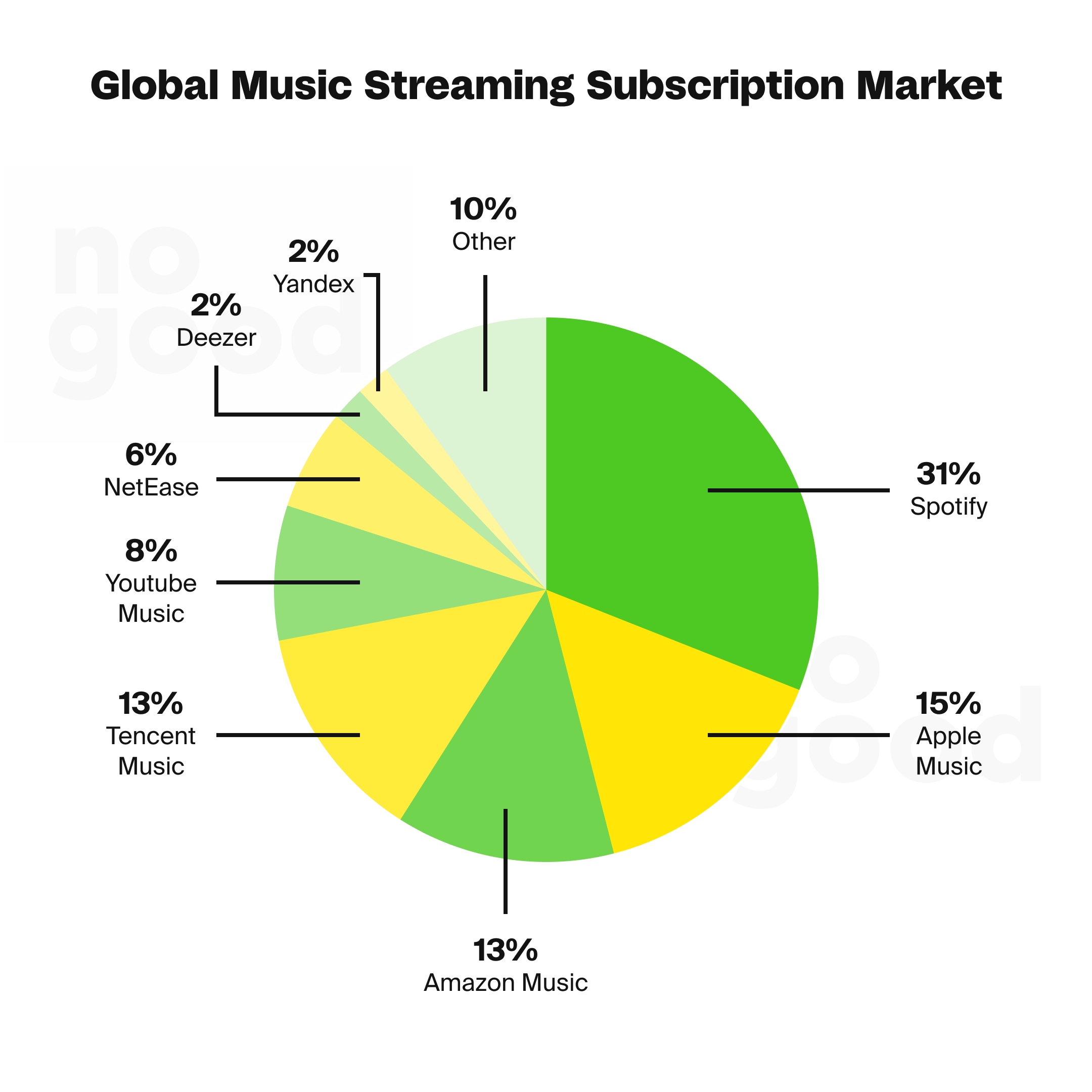
It’s safe to say that if you’re an artist or a podcaster trying to make it on Spotify, you need to refine your Spotify SEO strategy.
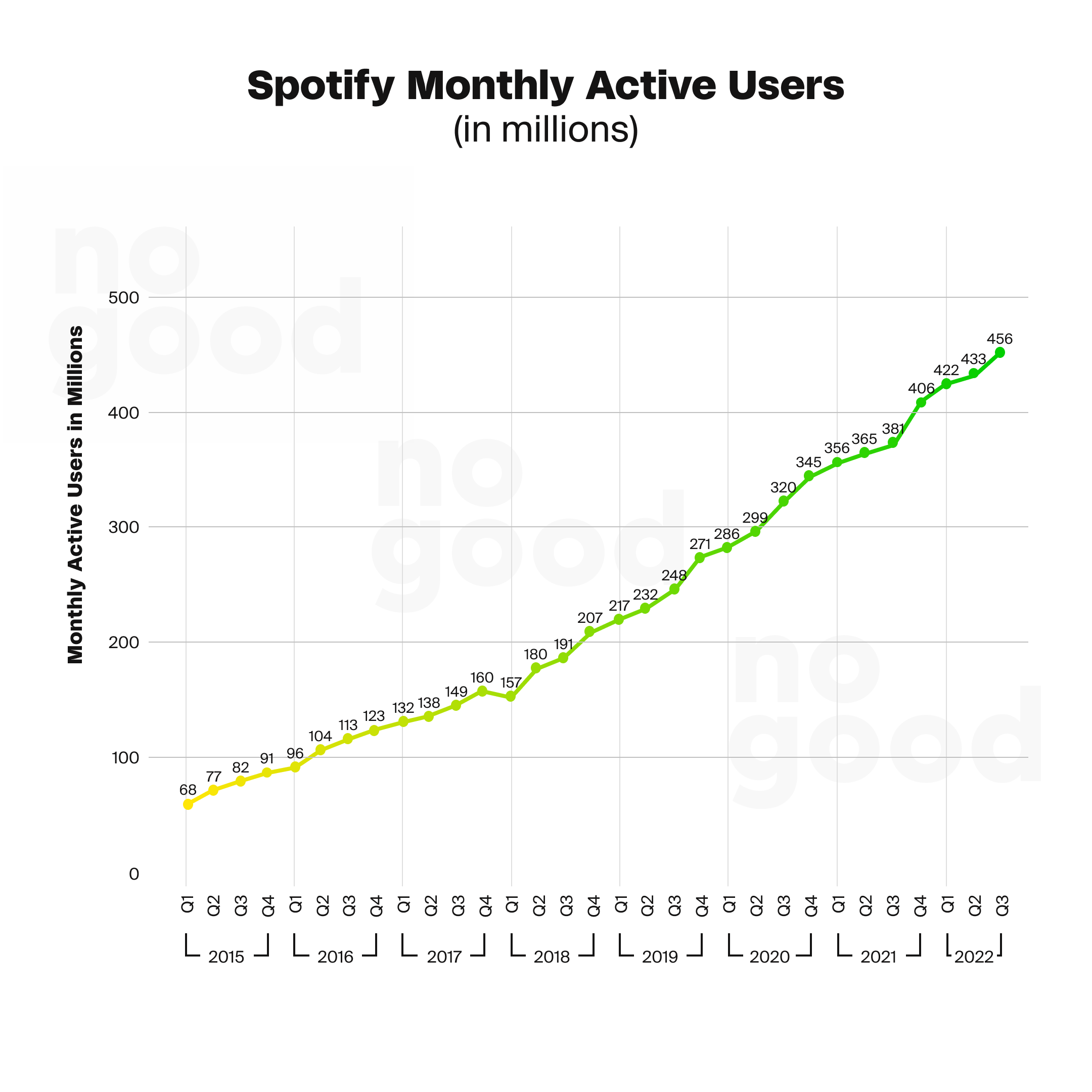
How Do I Get Noticed by the Spotify Algorithm?
There are three ways for your podcast or song to be found on Spotify; search, playlists, or featured by Spotify. From an SEO perspective, I like to think of these three visibility methods as the keywords, backlinks, and the Google algorithm respectively.
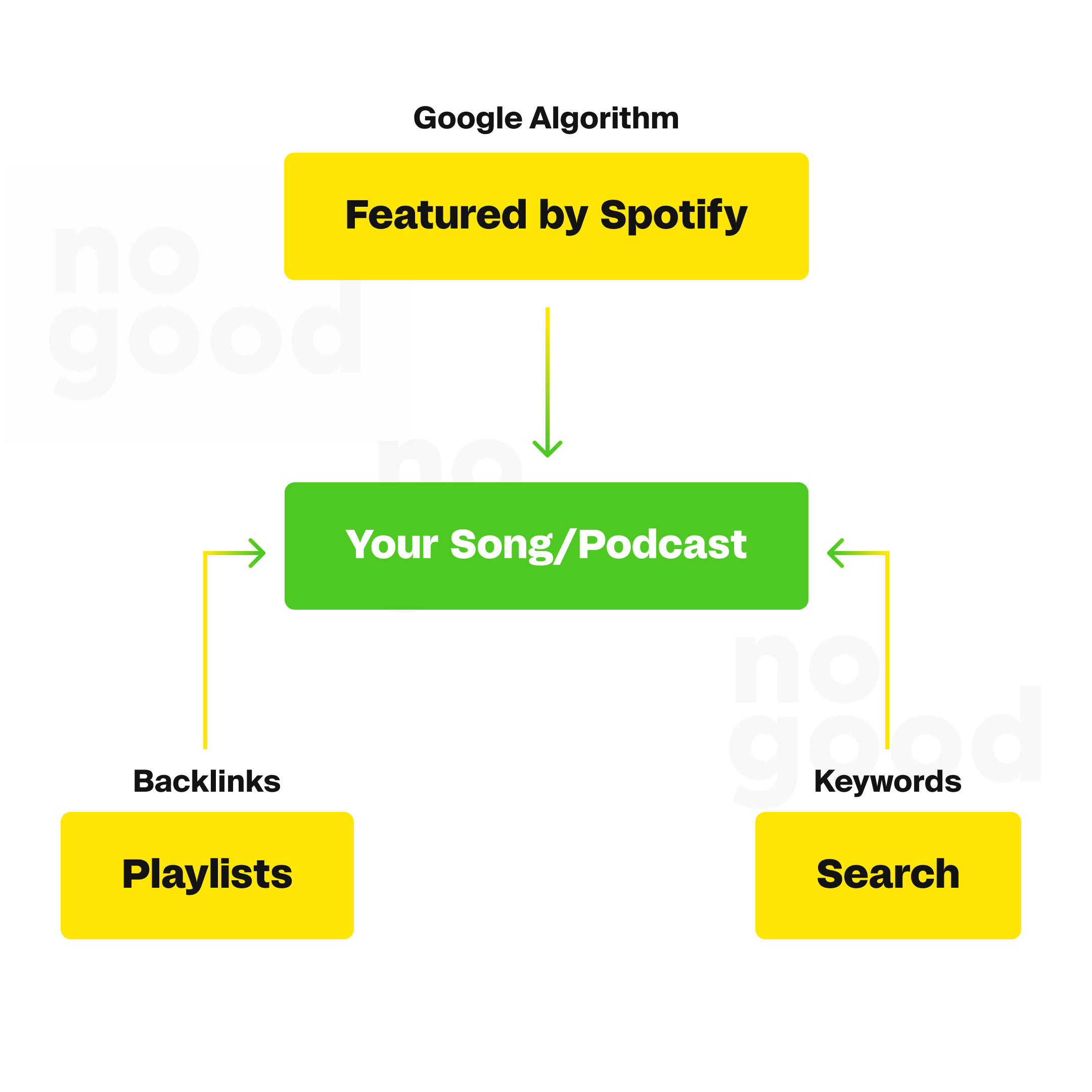
Optimize for Spotify Search Using Keywords
You can leverage keywords on Spotify by creating keyword-rich playlists and optimizing your artist or podcast homepage.
Keyword-Rich Playlists
Some of the most important ranking factors when it comes to playlists are playlist titles and descriptions. For example, if you are a musical artist trying to promote songs that would be good to listen to while working out, analyze the Sptofy search results for words related to “workout”. You’ll find that both the words “workout” and “work out” have entirely different results.
The word “workout” displays a workout mix playlist which indicates this may be an appropriate keyword for you to target. Whereas, “work out” features the song “Work Out” by J Cole. Although a great song…it’s not exactly aligned with hitting the gym.
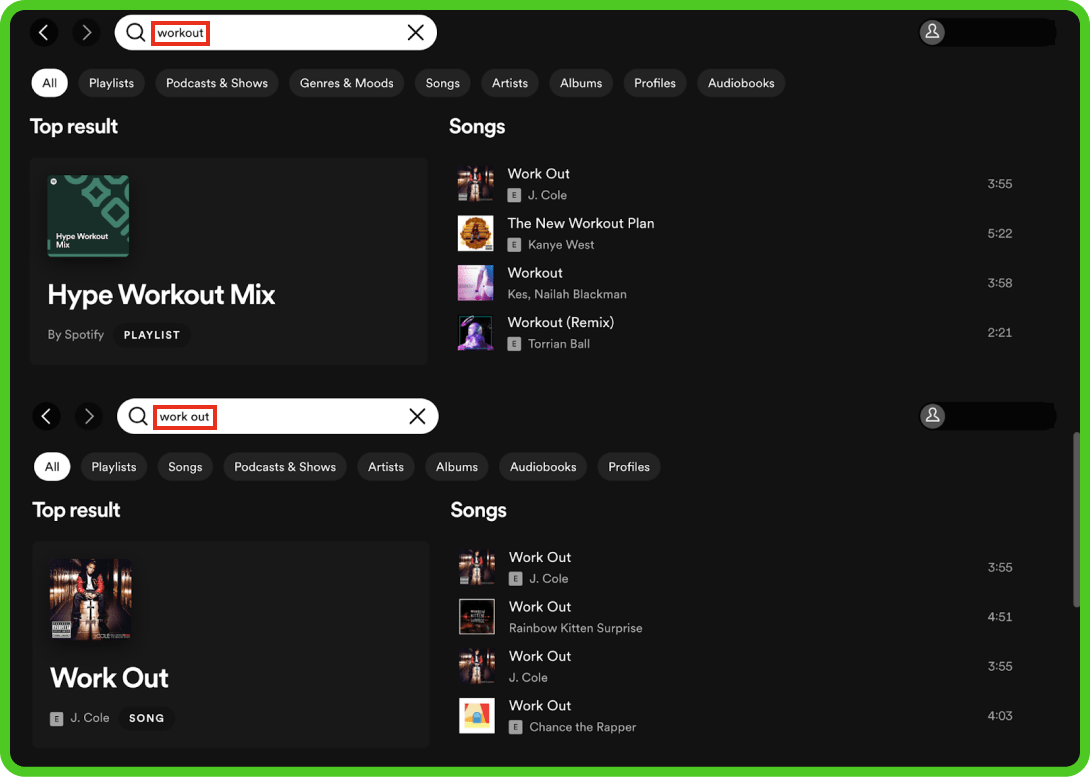
Once you’ve landed on your primary keyword, make sure you’re utilizing it in both your playlist title and description.
Playlists are a great way to increase organic visibility for newer artists or podcasters. You can include your content among content from your favorite artists/podcasters. The content from other popular artists or podcasters will help your playlist gain popularity and help listeners discover your content.
To increase the click-through rate (CTR) on your playlist, ensure you’re including relevant and eye-catching covert art that attracts your target audience. For example, if you’re creating a workout playlist for runners, you could include the cover art of someone running that your target audience can identify with.
Artist and Podcast Homepage Optimizations
It’s no secret that a catchy and memorable podcast name is going to help your content stand out. Alex Cooper, host of “Call Her Daddy”, Spotify’s number one most listened-to podcast among women globally, famously battled the media empire, Barstool Sports, for her intellectual property (IP) back in 2020. She won and was able to cement a $60 million deal with Spotify for the show. With over 5 million weekly listeners, Call Her Daddy, is easily one of the most recognizable podcast names globally.
This battle over name rights is a strong example of the importance of creating a catchy show title. Spotify’s guidelines for SEO-optimized show titles include skipping the following:
- Common or colliding names
- Unique spelling and special characters
- Long titles
- Generic words
They recommend adhering to the following title guidelines:
- Keep it short (three to four words).
- Avoid abbreviations, punctuation, and misspelled words that confuse the algorithm.
- Include a keyword that reflects your content.
- Be creative.
The second most important section of your podcast page is the description. The description is a known Sptofiy ranking factor and should include the following:
- The podcast host’s name
- Topics covered on the show
- Any abbreviations of the show’s name
- Stick to a hundred characters or less.
- Introduce yourself.
- Include primary and secondary keywords.
- Link your socials.
If you’re stuck, and looking for ways to optimize your podcast profile, review other podcasts within your category who produce similar content. How are they structuring their descriptions? What keywords can you identify? What do you wish they included in their profile? This information can help ensure your podcast homepage remains competitive.
If you’re a musical artist looking to optimize your artist profile then your About page is the perfect place to start. It can help to think of words that your fans might use to describe your music. To help you start developing your list, you can ask family and friends how they would describe your music. These keywords will help your artist profile gain visibility when listeners are searching for specific “vibes”, genres, or types of music.
It’s important that you don’t just simply enter a bulleted list of these keywords, but weave them in thoughtfully through your description. As much as you’re trying to rank and gain visibility, your fan experience should always remain the most important.
Besides important keywords, an artist profile should include the following key elements:
- Related genres
- Instrument you use
- Your musical influences
- Artists
- New songs
- Gig dates
- Music video
These are just a few examples of how to optimize your podcast and artist profiles for Spotify SEO. Spotify provides helpful resources for podcasters on optimizing show art, episode titles and descriptions, podcast promotions, and more. For artists, Music Gateway provides additional resources to artists for increasing organic reach across Spotify.
Building Backlinks on Spotify Using Playlists
In traditional search engine optimization backlinks are used to increase your authority and organic visibility. The equivalent for podcasters and artists on Spotify are playlists. The three types of playlists on Spotify are user-generated playlists, Spotify-curated playlists, and algorithm-generated playlists.
User-generated Playlists
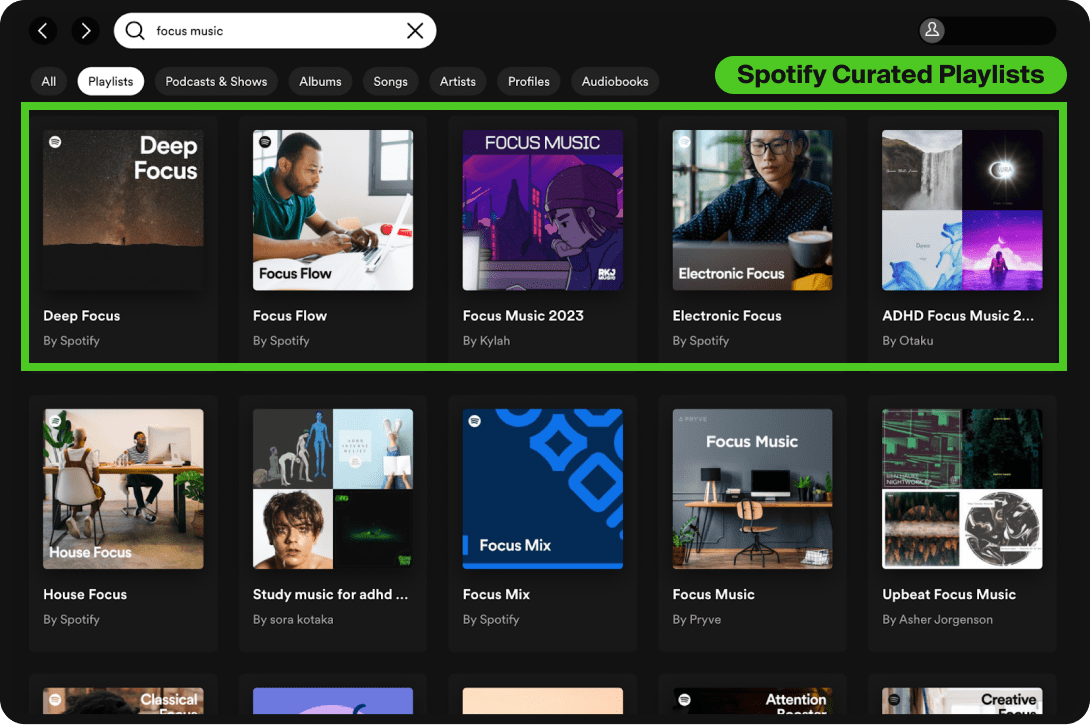
User-generated playlists are created by independent Spotify users and can be shared publicly or privately. As previously mentioned, you can create your own playlists to increase visibility, but you can also ask other playlist creators to include your content in theirs.
Going back to the workout playlist example, some fitness influencers will create playlists of their favorite music to listen to while working out and share it with their followers. This presents an opportunity for you to send your music to influencers who have publicly available playlists and enjoy your genre of music. If they agree to add your music to their playlist this can be a free way to increase distribution on Spotify and discover new listeners.
Additionally, if you’re a podcaster, you can reach out to influencers who have created a list of their favorite podcast episodes and ask to be included. However, it’s important to pursue playlists that align with your content and brand. Do not ask to be on playlists for the sake of getting mentioned. Make sure your content will provide value and align with the listeners’ interests.
Spotify-curated Playlists
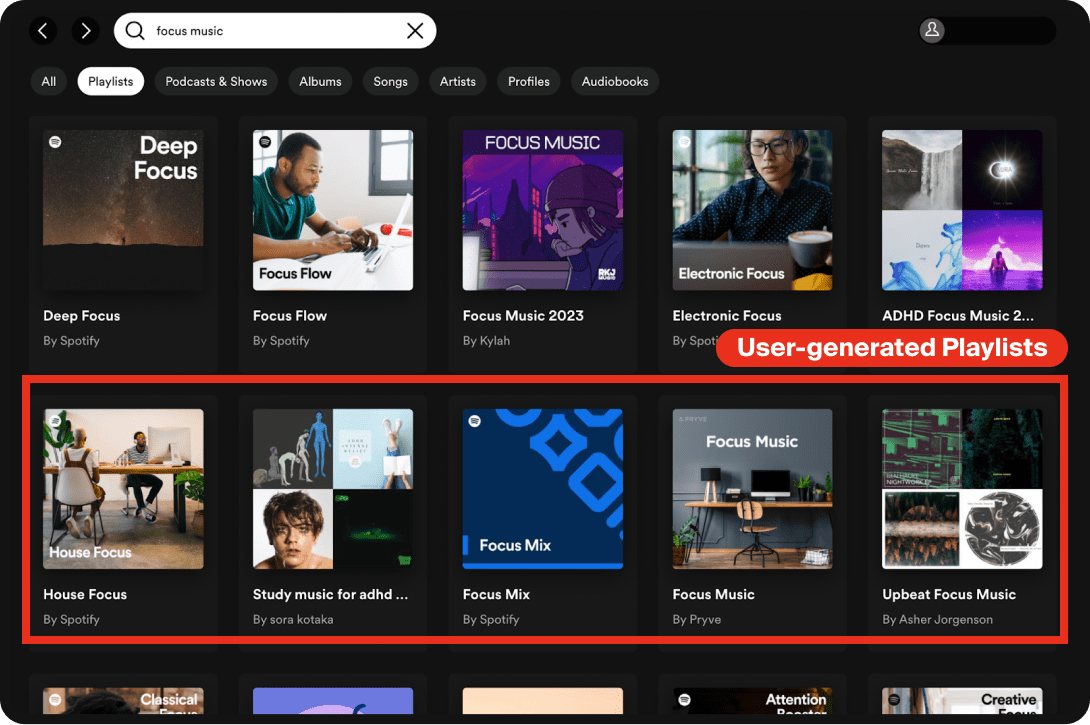
Spotify-curated playlists are a free way for artists to increase their distribution organically. To submit your song for playlisting it cannot be your first release, but you also do not have to be a superstar. Spotify says, “-more than 150,000 artists were playlisted for the first time across 2020 and 2021.”
You can submit your unreleased song for playlisting via your Spotify for Artists profile.
Algorithm-generated Playlists

This final playlist type relies mostly on chance. The featured songs on these playlists are entirely based on Spotify’s algorithm. For example, if you’re a Spotify user and see the “Daily Mix” section of your Spotify account, these are algorithms generated based on your listening history. However, as an artist, you can increase your chances of being listed on these playlists by implementing the artist profile optimizations listed above.
The Science of Creating Algorithm-Friendly Spotify Tracks
The Spotify algorithm utilizes a combination of artist-sourced metadata, raw audio signals, and natural language processing models to categorize and distribute the content on their platform.
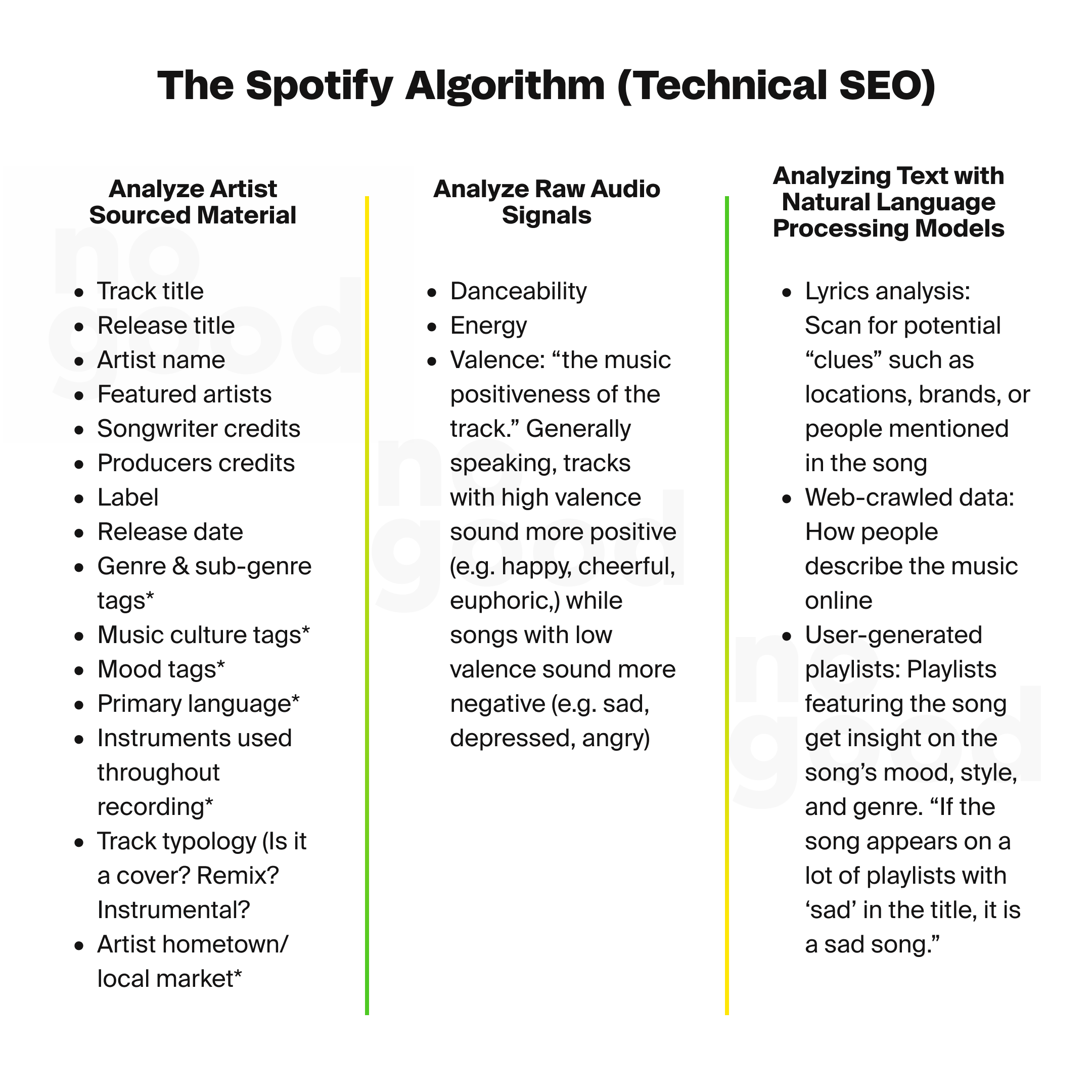
The artist-sourced metadata is sourced from your Spotify for Artists pitch form and is then submitted to the Spotify database. This information is then fed into content-based models and the recommendation algorithm.
Spotify says the approach they take to track representation is made up of two primary components:
- Content-based filtering, aiming to describe the track by examining the content itself.
- Collaborative filters, aiming to describe the track in its connection with other tracks on the platform by studying user-generated assets.
The second step of content-based filtering is perhaps the most impressive part of the Spotify algorithm; raw audio signals. This is where Spotify assigns numeric values to attributes of each song to help compare it to similar songs on the platform. Numeric values are applied to attributes such as danceability, energy, and valence (positivity level), just to name a few.
This means that tracks with similar scores can then be paired together in algorithm-generated playlists or Spotify-curated playlists. This also means that technically speaking, a song can be ENGINEERED to have similar numerical attributes as popular hits to increase the chance of being bucketed together.
In fact, Spotify for Developers has an interactive web API that allows you to gather these numerical values for any track on Spotify. Here’s how you can utilize this tool to evaluate how your songs stack up against some of your favorite music.
- You must be signed into your Spotify user account on a desktop browser.
- Open Spotify and start playing the song you would like to analyze.
- Right-click on the song, hover over “Share” and click “Copy Song Link”
- Copy the 22-digit Spotify ID after “open.spotify.com/track/”. Stop before you reach the question mark in the URL.
- Paste the song’s Spotify ID into the “id” field in the web API tool.
Now, you should see a response sample in the right-hand column with that song’s numerical attributes. Spotify also provides an explanation for each metric in the center of the page that discusses what it means and the associated ranges. This is where the intersection of science and art meets!
Lastly, Spotify analyzes associated text with natural language processing models. This analysis reviews lyrics, web-crawled data, and user-generated playlists. The lyric analysis scans for locations, brands, and people mentioned in the song that can create additional context. Web-crawled data comes mostly from music blogs and digital media to understand how people describe the song or artist. Then, by analyzing user-generated playlists, the NLP identifies the types of playlists the song is featured on and associated trends. For example, if a song appears on feel-good playlists, it’s a feel-good song.
All of these components combined make up the “Technical SEO of Spotify”. Similar to traditional search engine optimization, this backend data provides more context to algorithms to enable them to serve users more relevant content. It can also be optimized and refreshed to help increase visibility.
Ranking organically on Spotify has many of the same strategies you would find with Google. Creating shareable content, optimizing your content with keywords, obtaining backlinks, and making technical optimizations are the base elements of a Spotify SEO strategy. Whether you’re a musical artist who’s trying to convert from being a SoundCloud rapper or you’re an aspiring true crime podcaster, these strategies can help you expand your reach and get discovered.






